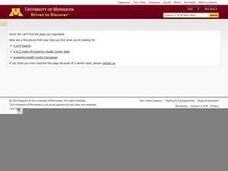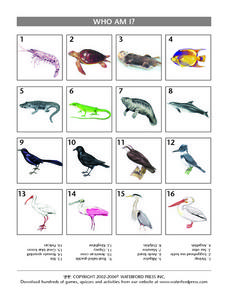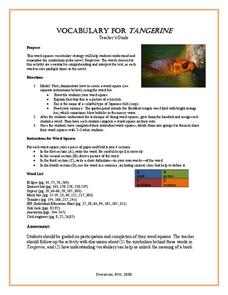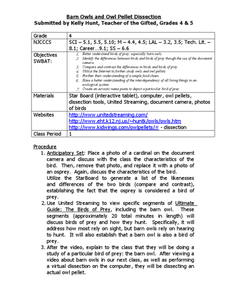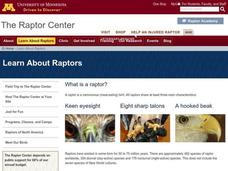Osprey Teacher Resources
Find Osprey lesson plans and worksheets
Showing 83 resources
Curated OER
Osprey Journey
Learners investigate the migration route of one bird, Osprey B4, using information gathered from satellites to track birds over a two-year period. They coimpare their graphs with maps of B4's migrations that have been plotted by...
Curated OER
Minnesota Ospreys and Migration
Students explore the route that Minnesota ospreys follow during spring and fall migration. They describe the important ecological characteristics of the places that ospreys pass through during their migration. They determine where...
Curated OER
Literature Quiz for Mother Osprey;
In this literature quiz, students first read the book Mother Osprey. Students then take a ten question multiple choice comprehension test about the book.
K5 Learning
The Fishhawk
Read about why the osprey is also known as the fishhawk in a short reading passage that describes where they live, what they eat, and what they look like. After reading, individuals respond to four short answer questions based on...
Curated OER
Lake and Pond Study
Students examine the habitat and community structure of a pond that could support Ospreys through games and worksheets. They then go on a field trip to a pond to evaluate the suitability of the pond as an Osprey habitat.
Curated OER
Predator-Prey Relationships
Students explore the interrelatedness of predators and prey in four different activities. They simulate an aquatic insect, fish, and osprey food chain during a poker chip game, play an M&M game to simulate the relationship between...
Curated OER
Nest Watch
Students describe the nests of three common birds. They build a specific type of bird nest, using the same materials a bird would use. Students build a nest platform to attract a nesting pair of osprey. They observe, record, and submit...
Curated OER
Shoreline Seining and Sampling
Learners investigate ecological systems and the cause and effect relationship between humans and the environment by using the prey items of Ospreys.
California Academy of Science
Using Empirical Data in the Classroom: Raptor Migrations!
Raptor flight patterns align with seasonal changes in net primary productivity. Here is a thought-provoking lesson that uses empirical data from a video to help scholars understand raptor migrations, producers/consumers, and ecosystems....
Curated OER
Who Am I? - Animal Picture and Word Match
In this matching worksheet, young scholars match the pictures of a variety of animals with their names which are located in a word bank at the bottom of the page. They see animals which include an osprey, an ibis, a pelican, and an...
Curated OER
My Favorite Meal
Young scholars investigate ecological systems and the multiple uses of the environment by studying the osprey population.
Curated OER
Birds of Prey Word Search
In this birds of prey word search worksheet, students search for the names of 19 birds of prey that are hidden in the puzzle. They search for words such as kielder, osprey, sparrow hawk, and vulture.
Curated OER
Separate Vacations
Students plot the migration paths of birds using latitude and longitude data from a table.
Curated OER
Log Canoes: A Chesapeake Bay Tradition
This activity uses a question and answer format to scaffold students comprehension of a short dialogue about the Chesapeake Bay and its tradition of log canoes. After reading the short passage, students are prompted to find three facts...
Curated OER
Tangerine: Vocabulary
Here's a great way to make vocabulary words drawn from Edward Bloor's novel Tangerine memorable. Kids create a word square, and in one quadrant write the word. A picture goes in a second quadrant, the definition in a third, and a...
KOG Ranger Program
A Place to Call Home
Lots of animals live in the forest, and some are easier to spot than others! Locate 12 animals and their preferred habitats within the forest with an engaging worksheet. After learners fill in the correct animal for each area, they...
Curated OER
Food Chain
Third graders role-play various organisms from a food chain to illustrate how a food chain works. In relay style, 3rd graders fill their cups (stomachs) and, in turn, fill a larger organism's cup (stomach) to visualize the importance of...
Curated OER
Mouse...Mouse...Snake!
Use this activity as an anticipatory set to warm up for a lesson plan on predator/prey relationships. Pupils will play a round of "Duck, Duck, Goose," substituting the ducks and geese for two animals that have a predator/prey...
Curated OER
Barn Owls and Owl Pellet Dissection
Students explore birds of prey and food chains. In this ecosystems and birds of prey cross curriculum science and literacy lesson, students brainstorm characteristics of birds after viewing photographs. Students view a video and document...
Curated OER
Food Chain
Third graders explore why food chains are important. In this food chain lesson, 3rd graders break into small groups to represent parts of the food chain. Different amounts of food are given to each group and any spilled food will be...
Curated OER
What is a Raptor?
Students explore, analyze and discover the characteristics of raptors and generate a word bank for owls and raptors. They identify attributes shared by raptors and practice various key vocabulary words to master and utilize in sentence...
Curated OER
Log Canoes: A Chesapeake Bay Tradition
For this reading comprehension worksheet, students read a story about log canoes on the Chesapeake Bay and examine the dialogue between characters. Students use the dialogue between the characters to answer five short answer questions.
Curated OER
The Rain Forest
Pupils explain the basics of the tropical rain forest ecosystem. They list the four general layers of vegetation found in the tropical rain forest.









